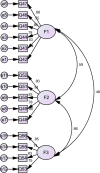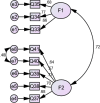Inflammatory bowel disease patients' perspectives of non-medical needs
- PMID: 38615013
- PMCID: PMC11016217
- DOI: 10.1186/s12876-024-03214-x
Inflammatory bowel disease patients' perspectives of non-medical needs
Abstract
Background: Inflammatory bowel disease (IBD) imposes a huge burden on the healthcare systems and greatly declines the patient's quality of life. However, there is a paucity of detailed data regarding information and supportive needs as well as sources and methods of obtaining information to control different aspects of the disease from the perspectives of the patients themselves. This study aimed to establish the IBD patients' preferences of informational and supportive needs through Exploratory Factor Analysis (EFA) and Confirmatory Factor Analysis (CFA).
Methods: IBD patients were recruited from different centers. Considering inclusion and exclusion criteria, 521 participants were filled a predefined questionnaire. This questionnaire was prepared through literature review of the recent well-known guidelines on the needs of IBD patients, which was further approved by the experts of IBD area in three rounds of Delphi consensus. It includes 56 items in four sections of informational needs (25), supportive needs (15), sources of information (7), and methods of obtaining information (9).
Results: In particular, EFA was used to apply data reduction and structure detection. Given that this study tries to identify patterns, structures as well as inter-relationships and classification of the variables, EFA was utilized to simplify presentation of the variables in a way that large amounts of observations transform into fewer ones. Accordingly, the EFA identified five factors out of 25 items in the information needs section, three factors out of 15 items in the supportive needs section, two factors out of 7 items in the information sources section, and two factors out of 9 items in the information presentation methods. Through the CFA, all 4 models were supported by Root Mean Squared Error of Approximation (RMSEA); Incremental Fit Index (IFI); Comparative Fit Index (CFI); Tucker-Lewis Index (TLI); and SRMR. These values were within acceptable ranges, indicating that the twelve factors achieved from EFA were validated.
Conclusions: This study introduced a reliable 12-factor model as an efficient tool to comprehensively identify preferences of IBD patients in informational and supportive needs along with sources and methods of obtaining information. An in-depth understanding of the needs of IBD patients facilitates informing and supporting health service provision. It also assists patients in a fundamental way to improve adaptation and increase the quality of life. We suggest that health care providers consider the use of this tool in clinical settings in order to precisely assess its efficacy.
Keywords: Confirmatory factor analysis; Exploratory factor analysis; Inflammatory bowel diseases; Needs assessment.
© 2024. The Author(s).
Conflict of interest statement
The authors declare no competing interests.
Figures




Similar articles
-
Expert opinions on informational and supportive needs and sources of obtaining information in patients with inflammatory bowel disease: a Delphi consensus study.Front Psychol. 2023 Sep 21;14:1224279. doi: 10.3389/fpsyg.2023.1224279. eCollection 2023. Front Psychol. 2023. PMID: 37809295 Free PMC article.
-
Using Exploratory and Confirmatory Factor Analysis to understand the role of technology in nursing education.Nurse Educ Today. 2020 Sep;92:104490. doi: 10.1016/j.nedt.2020.104490. Epub 2020 Jun 2. Nurse Educ Today. 2020. PMID: 32516637
-
The Knee Injury and Osteoarthritis Outcome Score Does Not Have Adequate Structural Validity for Use With Young, Active Patients With ACL Tears.Clin Orthop Relat Res. 2022 Jul 1;480(7):1342-1350. doi: 10.1097/CORR.0000000000002158. Epub 2022 Mar 2. Clin Orthop Relat Res. 2022. PMID: 35238805 Free PMC article. Clinical Trial.
-
Validity and Reliability of the Newly Developed Malay-Language Health Belief of Bloating (HB-Bloat) Scale.Int J Environ Res Public Health. 2020 Apr 17;17(8):2773. doi: 10.3390/ijerph17082773. Int J Environ Res Public Health. 2020. PMID: 32316495 Free PMC article.
-
Identification of the informational and supportive needs of patients diagnosed with inflammatory bowel disease: a scoping review.Front Psychol. 2023 May 11;14:1055449. doi: 10.3389/fpsyg.2023.1055449. eCollection 2023. Front Psychol. 2023. PMID: 37251032 Free PMC article.
Cited by
-
Exploring the multidimensional impact of caregiver burden in patients with inflammatory bowel disease.Front Public Health. 2025 May 29;13:1528778. doi: 10.3389/fpubh.2025.1528778. eCollection 2025. Front Public Health. 2025. PMID: 40510583 Free PMC article.
-
Effect of a gamified mobile-based self-management application on disease activity index, quality of life, and mental health in adults with inflammatory bowel disease: A protocol of a randomized controlled trial study.Health Sci Rep. 2024 May 21;7(5):e2109. doi: 10.1002/hsr2.2109. eCollection 2024 May. Health Sci Rep. 2024. PMID: 38779219 Free PMC article.
-
Developing and evaluating a gamified self-management application for inflammatory bowel disease using the ADDIE model and Sukr framework.BMC Med Inform Decis Mak. 2025 Jan 8;25(1):11. doi: 10.1186/s12911-024-02842-3. BMC Med Inform Decis Mak. 2025. PMID: 39780171 Free PMC article.
-
Care needs profiles of Crohn's disease patients and their associations with symptom clusters, post-traumatic growth, and family function: a latent profile analysis.BMC Gastroenterol. 2025 May 9;25(1):351. doi: 10.1186/s12876-025-03953-5. BMC Gastroenterol. 2025. PMID: 40346452 Free PMC article.
References
Publication types
MeSH terms
LinkOut - more resources
Full Text Sources
Miscellaneous

